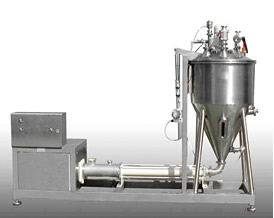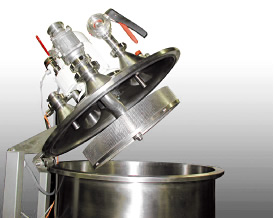

Efficient de-aeration for a higher product stability
The vacuum de-aerator is suited for the de-aeration of liquid up to
paste-like products that have not been manufactured under vacuum
and therefore contain air. The plant operates continuously and is
usually the last unit in a production line.
-
Prevention of oxidative modifications such as discolouration, alteration in flavour and aroma occurring especially in fat and oil.
-
Regular glossy product surface, enhanced long-time stability reached by de-aeration.
- From approx. 200 l/h - 20,000 l/h

|
System optimally adjustable to the different products
- Air-free products increase the accuracy in dosing of downstream filling units
- Higher product density enables to reduce packaging volume
- Easy maintenance and cleaning
Product feed
- The product is always fed via a feeding pump. This one can be an eccentric screw pump or a rotary piston pump. The feeding pump is not included in our regular scope of delivery.
Distributing system
- By its dynamics the distributing system enables to efficiently de-aerate liquid up to paste-like products.
- The product is fed via a pump. The product flows on the rotating distributing disc via the feeding pipe. Through the centrifugal force the product regularly spreads forming a thin film. It passes through the sieving ring and is projected against the inside wall of vessel. Under vacuum action in the vessel the air bubbles stretch, burst and are continuously sucked off by the vacuum pump.
- The diameter of the perforations of the sieving ring depends on the application; it is comprised between 0.7 and 3 mm. Because the product in form of a thin film first flows along the inside wall of vessel and therefore remains longer in the vessel, an additional effect of de-aeration is attained. Achievable results: gas residual up to 1% and less.
Vacuum system
- A water ring pump is used as a vacuum pump. Vacuum is continuously adjusted.
Product discharge
- The de-aerated product concentrates in the bottom of the vacuum vessel from which it is discharged by an eccentric screw pump. The pressure measured at the outlet of the discharge pump depends on the vacuum level and the viscosity but it always reaches at least 2 bar. The discharge pump is driven by a continuously adjustable gear motor. The discharge pump can be delivered in quick-cleaning construction or suited for CIP cleaning.
Controle
- The complete control is built in a stainless steel cabinet mounted on the base frame of the plant. Control type: Siemens PLC.
Cleaning
- As standard the plant is so designed that it can be cleaned by CIP.
|







![]()

